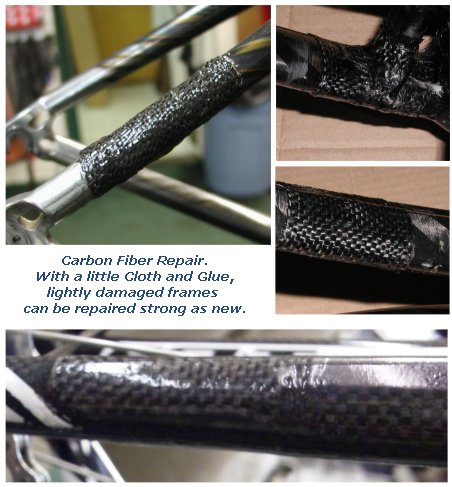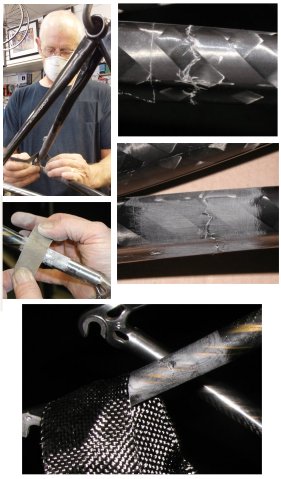|
Cloth and Glue
Carbon fiber as viewed by Patrick Angel, Service Manager of PMB Inc.
Carbon fiber has incredible capability as demonstrated daily in the real world. There is no denying that advancements in recent years have leapt forward past the wildest dreams of Union Carbide scientist Dr. Roger Bacon who first discovered the "graphite whiskers" back in 1958 (source: http://www.wipo.int/ipadvantage/en/details.jsp?id=2909). As with such technology there is the usual band of skeptics, proponents, and opponents concerning its application, care and so on. This is, as much as possible anyway, a practical, sobering, real world view of the engineering and the finished product coming from the 20/20 vision of a front-lines wrenchman.
Application
There is no limit to what can be made from carbon fiber just as there is really no limit to what can be made with any sort of composite material, but for this article, we'll concentrate only on bicycles. Bicycles are a unique case, because virtually everything on a bicycle is STRUCTURAL. The wheels, seatpost, stem, handlebars, all of it; has to be capable of holding up the weight of the rider, which is several times its own weight in most cases. Even the cheapest, heaviest, poorly equipped bikes still, on average, weigh only half of what they are rated for. A single pound carbon fiber hood scoop for a racing car only has to realistically hold up its own weight, for example, but a two and a half pound carbon fiber racing bicycle frame has to be able to hold up the 150 pound racer that rides on it. This is why cheap knockoff carbon fiber is a no-no that must be avoided at all costs. A vendor which we work with has recently told us about a close friend that wrecked because his knock-off frame broke last year, and is still recovering from injuries. The same has been true for other materials for years. Aluminum bicycle frames were also tricky-sticky race pieces when they first came out, and cheap knockoff aluminum continues to suffer the same problem as well. The current problem with both materials in this application are, you have really three options- light, strong, and cheap; and you only get to pick two. In other words, when going for leading technology material to be a structural piece, go with an industry leader sort of company.
Care
Carbon fiber as a material is very tough and resilient. Most of the time you'll never have anything to worry about, or really, anything to repair. Most items made from CF are typically finish coated with a non-structural layer (usually a clear-coat with some stickers under it), and as such you can wax it no different than you would your car. There are some things worthy of mentioning, however. Like any composite, carbon fiber is resistant to cracking and breaking up to a certain stress point. This means, that, so long as you do not exceed the test load for a given piece you'll be fine. However, I, like most bicycle carbon manufacturers rightly specify that any bicycle carbon frame that has been through anything beyond a small crash should be considered totaled, EVEN IF THERE IS NO OUTWARD APPEARANCE CHANGE OR VISIBLE DAMAGE. This is EVEN in lieu of the fact that we offer fiber repair at our shop. I'll explain this Jekyll and Hyde view in a moment. There are essentially two types of carbon fiber damage. Here they are-
1) The localized impact. This is more common than you think. This is usually caused when a rear deraileur is poorly adjusted. It gets shifted to first gear during a ride, goes past first, catches a spoke on the spinning wheel, breaking the hanger off, and around it comes, striking the seat stay, sometimes with enough force to break through the tubing entirely. This repair is not only feasible, but these days, reasonable, and as the raw material price continues to trickle down through its own advancement, economical. This is because it's only broken in one spot, and you know exactly where to put the new material and how it broke in the first place. In this sort of repair, the rest of the frame is still intact, and can even be used as a reference point for making the repair. We have done a few of these repairs in house and stand behind repairs of this sort.
2) Full body impact. This is the sort of thing manufacturers total a frame for. This is usually caused when a rider and bike are involved in an accident involving an automobile, stunting, or an ex-wife. Whenever a carbon fiber framed anything goes through and past its load test, beyond its stress point for any reason, ,whether it's crush stress or twist stress, or pull stress, the material can crack at a microscopic level just before it breaks apart. Once it cracks at a microscopic level, its load test rating for that spot drops dramatically. There are several problems here. First, because virtually all carbon fiber bicycle frames are clear coated on at least the exterior side (some are internally as well), the inspection process is not possible without sanding off at least most if not all of the paint, which, if you are looking for a crack in a frame, means the entire pretty paint job and all of the irreplaceable factory stickers are gone. Second, Because the whole point of a carbon fiber bicycle is to perform as a lightweight superbike, your repair had better not add much weight or it defeats its own purpose by making you uncompetitive by way of weight penalty. Ergo, you can't just add a 1/16" coat of resin and fiber to the entire bike, even though that would "mechanically" work; it would be heavy, slow, and probably silly looking, and it might possibly still not even ride right, all at the same time. One frame manufacturer once told me at a trade show that to inspect it, they'd have to "cut it up".
Summary
In short, carbon fiber is a great material that seems to have been plucked from the future. Fortunately for the rest of us mere mortals, you don't have to get it up to 88 miles an hour to enjoy it; you just have to pedal hard enough to hit your goals, and remember it's way more complex than just cloth and glue.
Patrick Angel
PMB Team
|
|














